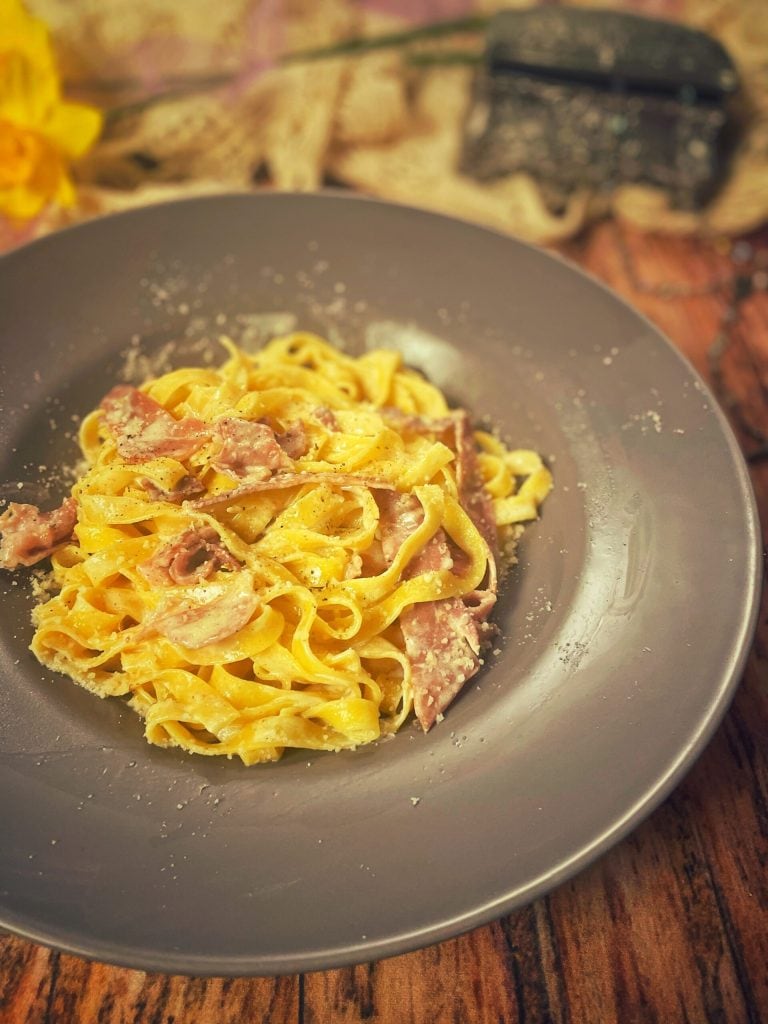The fettuccine alla papalina is said to have originated in the 1950s in Rome, and the dish was named after Giovanni Pietro Bellori, a cardinal who was also a great lover of good food.
The recipe was supposedly created in his honor or, more precisely, as a tribute to his passion for rich and creamy dishes, like “pasta alla carbonara,” which, although similar in base, has its own distinct identity.
There are several legends about how the dish was born, but the most credited version is that Cardinal Bellori was known for his banquets and his love for fettuccine, which, at that time, were prepared in various ways.
A chef in a Roman restaurant created a special version enriching it with cream, prosciutto, and butter to satisfy the cardinal’s tastes.
The dish, then, was named “fettuccine alla papalina” in his honor, to link the recipe to his name and his position.
The term “papalina” actually refers to the honorific title attributed to a figure linked to the Pope (in this case, the cardinal).
“Papalina” recipes were quite common in Roman cuisine of the time and usually referred to dishes prepared for the papal court or religious dignitaries.
Indeed, “papalina” evoked the idea of a rich dish, exquisite and suitable for a person of rank.
The traditional recipe consists of cream, prosciutto, butter and Parmesan.
In its modern version, some variations have been made, such as adding Pecorino Romano instead of Parmesan Reggiano or replacing prosciutto with guanciale.
The recipe is dedicated to the film “Conclave” nominated for 8 Oscars including Best Picture, for the Oscar Menu.
Plot: Cardinal Lawrence (Ralph Fiennes) is tasked with leading the conclave to elect the new pope.
Once the most powerful leaders of the Catholic Church gather and are locked in the secret rooms of the Vatican, Lawrence finds himself trapped in a web of intrigue, betrayal, and power games.

- Difficulty: Very Easy
- Cost: Economical
- Preparation time: 9 Minutes
- Portions: 4 People
- Cooking methods: Stovetop
- Cuisine: Italian
- Seasonality: All Seasons
Ingredients
- 14 oz egg pasta fettuccine
- 3.5 oz prosciutto (single slice)
- 2/3 cup fresh liquid cream
- 3.5 oz butter
- 1.75 oz Parmigiano Reggiano DOP (+ decoration)
- to taste salt and pepper
Steps
Cook the fettuccine in plenty of salted water, following the cooking times indicated on the package, but draining them al dente (save some cooking water for possible adjustments in creaminess).
In a large pan, melt the butter over medium heat. Add the prosciutto cut into thin strips and sauté gently for a couple of minutes.
Add the cream and mix well, bringing the sauce to a light boil. Continue to cook on low heat until the cream has thickened a bit, but without reducing it too much.
Now add the grated Parmesan and stir to melt it, creating a creamy sauce.Toss the freshly drained fettuccine in the pan with the sauce (and some pasta cooking water) and mix well to combine them with the sauce. If necessary, adjust with salt and pepper.
Plate and serve immediately, garnishing with a bit of freshly grated Parmesan and a sprinkle of black pepper.
The DVD of “Conclave” will be available starting April 3, 2025.
FAQ (Frequently Asked Questions)
What are the other variants of fettuccine alla papalina?
Fresh cream is the classic ingredient, but some variants on the web suggest using cooking cream, which tends to be thicker and more economical, but in some cases also less delicate in flavor.
In many modern variants, prosciutto is replaced with cooked ham or even guanciale.
Some chefs suggest adding chili or aromatic herbs (like rosemary or basil) and a bit of white wine to deglaze the prosciutto and to add some acidity to the sauce.
Finally, it is sometimes suggested to do a pasta sauté, which means finishing the fettuccine cooking directly in the pan with the sauce to better absorb the flavors.What is the difference between fettuccine and tagliatelle?
Fettuccine differ from tagliatelle by being narrower, between 3 and 5 millimeters.
They also differ from tagliatelle by being a bit thinner.
This format is more typical of central Italy regions, particularly Lazio.What were Pope Francis’ favorite dishes?
Among Pope Francis’ favorite dishes were risotto alla piemontese (an Argentinian dish), dulce de leche, empanadas, asado, pasta dumplings, and mate.
There is also a book dedicated to Pope Bergoglio’s most beloved recipes: “A tavola con Papa Francesco” by Roberto Alborghetti.

